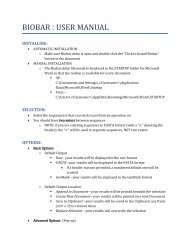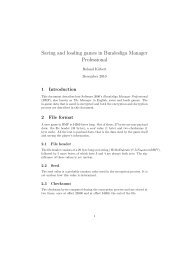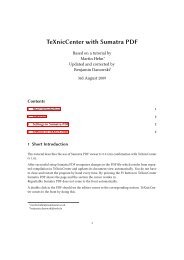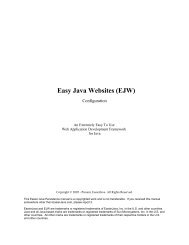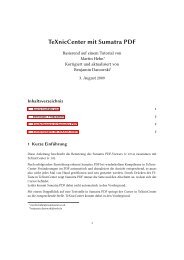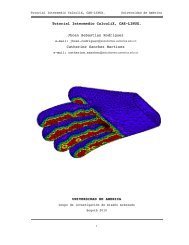Postgres-XC
Postgres-XC
Postgres-XC
You also want an ePaper? Increase the reach of your titles
YUMPU automatically turns print PDFs into web optimized ePapers that Google loves.
<strong>Postgres</strong>-<strong>XC</strong> Install Manual Version 0.9.5<br />
<strong>Postgres</strong>-<strong>XC</strong><br />
Install Manual<br />
Version 0.9.5<br />
NTT Open Source Software Center<br />
June 30 th , 2011<br />
© 2010-2011 by Nippon Telegraph and Telephone Corporation
Table of Contents<br />
<strong>Postgres</strong>-<strong>XC</strong> Install Manual Version 0.9.5<br />
1. Code Acquisition.................................................................................................................................<br />
3<br />
2. <strong>Postgres</strong>-<strong>XC</strong> Quick Start.....................................................................................................................<br />
3<br />
2.1Recommended environment..........................................................................................................<br />
3<br />
2.2Install commands...........................................................................................................................<br />
4<br />
2.3Environment initialization and setting...........................................................................................<br />
4<br />
2.4Quick Setup....................................................................................................................................<br />
5<br />
2.4.1Configuration file setting........................................................................................................<br />
5<br />
2.4.2pg_hba.conf setting.................................................................................................................<br />
6<br />
2.5Launching Components.................................................................................................................<br />
6<br />
3. <strong>Postgres</strong>-<strong>XC</strong> detailed installation........................................................................................................<br />
7<br />
3.1Configure........................................................................................................................................<br />
7<br />
3.2Make...............................................................................................................................................<br />
8<br />
4. <strong>Postgres</strong>-<strong>XC</strong> setting.............................................................................................................................<br />
8<br />
4.1initdb..............................................................................................................................................<br />
8<br />
4.2Configuration files.........................................................................................................................<br />
9<br />
4.2.1Datanode configuration.........................................................................................................<br />
10<br />
4.2.2Coordinator configuration.....................................................................................................<br />
11<br />
4.3Start up.........................................................................................................................................<br />
15<br />
4.3.1GTM......................................................................................................................................<br />
15<br />
4.3.2GTM proxy...........................................................................................................................<br />
16<br />
4.3.3Launching Data Nodes and Coordinators<br />
............................................................................ 16<br />
5. <strong>Postgres</strong>-<strong>XC</strong> start/stop functions: pg_ctl and gtm_ctl functionalities..............................................<br />
17<br />
5.1pg_ctl module...............................................................................................................................<br />
17<br />
5.2gtm_ctl module............................................................................................................................<br />
17<br />
2
1. Code Acquisition<br />
<strong>Postgres</strong>-<strong>XC</strong> Install Manual Version 0.9.5<br />
Code can be downloaded from the Source Forge <strong>Postgres</strong>-<strong>XC</strong> development page.<br />
It can be taken from the public git repository in Source Forge. Install at least git 1.6.0 (supported by<br />
Source Forge) on your machine, and type the following command:<br />
git clone git://postgres-xc.git.sourceforge.net/gitroot/postgres-xc/postgres-xc<br />
Installing <strong>Postgres</strong>-<strong>XC</strong> from source code requires at least gcc version 4.1 or higher and GNU make.<br />
You may need flex later than 2.5.4 and bison later than 1.875.<br />
2. <strong>Postgres</strong>-<strong>XC</strong> Quick Start<br />
This section presents how to quickly install <strong>Postgres</strong>-<strong>XC</strong>.<br />
Please refer to part 3 for a more detailed procedure.<br />
2.1 Recommended environment<br />
Here is the basic structure used for <strong>Postgres</strong>-<strong>XC</strong> cluster:<br />
Figure 1 <strong>Postgres</strong>-<strong>XC</strong> environment and configuration<br />
3
<strong>Postgres</strong>-<strong>XC</strong> Install Manual Version 0.9.5<br />
This environment structure has been used to make <strong>Postgres</strong>-<strong>XC</strong> run as efficiently as possible by<br />
dividing processes efficiently. With (n+1) servers (n nodes and one GTM) , GTM is on a dedicated<br />
node and each other server is running one coordinator and one data node process of <strong>Postgres</strong>-<strong>XC</strong>.<br />
Having the Coordinator and Datanode processes together and on each node allow for an even<br />
distribution of workload. Also, reads from replicated tables can happen locally without requiring an<br />
additional network shop.<br />
The (n+1) servers are set on the same IP segment.<br />
The GTM server may be of a different class of server than the other components. It does not require<br />
have the storage requirements of the other components for example.<br />
Note: the user is free to spread the components as he wants. This configuration depends highly on<br />
the application layer used. When testing with a benchmark called DBT-1, classified as CPU-bound,<br />
<strong>Postgres</strong>-<strong>XC</strong> development team witnessed about 25-30% of CPU time being taken up by the<br />
Coordinator processes, and the rest by the Data Node processes.<br />
2.2 Install commands<br />
The software has to be installed from the source code, which can be done easily with the following<br />
commands, operation on to be in each of the (n+1) servers of the cluster:<br />
./configure CFLAGS="-DPG<strong>XC</strong>"<br />
make<br />
make install<br />
Everything will be installed in the folder /usr/local/pgsql by default, unless overridden with –prefix<br />
option when running configure.<br />
“make install” has to be done as user root if installing in /usr/local/pgsql.<br />
Note: <strong>Postgres</strong>-<strong>XC</strong> uses by default a CFLAGS called DPG<strong>XC</strong> when compiled. This flag is activated<br />
by default. In order to disable this flag, A flag UPG<strong>XC</strong> (undefine <strong>Postgres</strong>-<strong>XC</strong>) has to be set as<br />
CFLAGS.<br />
2.3 Environment initialization and setting<br />
Coordinators, Data Nodes and GTM require data directories for storing their data. The coordinator<br />
4
<strong>Postgres</strong>-<strong>XC</strong> Install Manual Version 0.9.5<br />
storage requirements are modest, as it is mainly catalog information, but data nodes may require<br />
much more, depending on the database.<br />
An example for data directories appears below. Assume that the desired root data directory is /data.<br />
mkdir /data<br />
mkdir /data/coord /data/datanode /data/gtm<br />
It can be also necessary for initdb process to allow access to the data directory for a proper<br />
initialization of the environment. Be sure to launch:<br />
chown username /data<br />
chown username /data/datanode /data/gtm /data/coord<br />
Then launch the following commands to initialize your environment:<br />
initdb –D /data/coord<br />
initdb –D /data/datanode<br />
In each coordinator/datanode folder, a postgresql.conf and pg_hba.conf file will appear.<br />
The next step is to set up those files.<br />
Initialization is not required for GTM but the data folder has to be set up when launching the<br />
process.<br />
2.4 Quick Setup<br />
This part explains how to quickly configure the <strong>Postgres</strong>-<strong>XC</strong> cluster.<br />
2.4.1 Configuration file setting<br />
Based on Figure 1, initialize the following values in postgresql.conf file located in the folder<br />
coordinator of server i (i between 1 and n):<br />
- pooler_port = 6667<br />
- num_data_nodes = n<br />
- coordinator_hosts = list of the IP addresses of the n <strong>Postgres</strong>-<strong>XC</strong> servers<br />
- coordinator_ports = 5432<br />
- data_node_hosts = list of the IP addresses of the n <strong>Postgres</strong>-<strong>XC</strong> servers<br />
- data_node_ports = 15432<br />
5
- gtm_host = GTM ip address<br />
- gtm_port = GTM process port<br />
- pgxc_node_id = i<br />
<strong>Postgres</strong>-<strong>XC</strong> Install Manual Version 0.9.5<br />
It doesn't cause any problems if the above values are the same on all nodes. It is actually encouraged,<br />
as it makes maintenance easier.<br />
pgxc_node_id plays an important roles for Coordinator because it permits the local coordinator to<br />
identify itself in the arrays coordinator_ports and coordinator_hosts. For example, by setting<br />
pgxc_node_id at 2, coordinator using this value thinks that its own IP and port are the second<br />
elements in the coordinator setting arrays. Such a definition is thought more simple in the cluster<br />
because it permits to keep the same arrays of data for Coordinators on all the Coordinator nodes.<br />
A similar setting has to be done in postgresql.conf file located in the folder datanode of server i (i<br />
between 1 and n):<br />
- gtm_host = GTM ip address<br />
- gtm_port = GTM process port<br />
- pgxc_node_id = i<br />
2.4.2 pg_hba.conf setting<br />
Add in each pg_hba.conf file of both coordinator and datanode folder the following line at the end<br />
of the file:<br />
host all all segment_IP.0/24 trust<br />
This will allow each component to communicate with other components in the cluster.<br />
If you have stricter security requirements, you can be more precise and modify accordingly. Please<br />
refer to the PostgreSQL documentation for more details.<br />
2.5 Launching Components<br />
Figure 1 shows the minimum options necessary to launch it correctly.<br />
In GTM machine, begin by launching GTM with the following command (it is important to start<br />
GTM before the other components for node registration):<br />
gtm -x 628 -p 6666 -D /data/gtm &<br />
6
<strong>Postgres</strong>-<strong>XC</strong> Install Manual Version 0.9.5<br />
-D option is mandatory for GTM, to make it consistent with PostgreSQL APIs.<br />
It is also possible to launch an additional component called GTM Proxy so as to limit the network<br />
load between Coordinators and GTM. Please refer to section 4.3.2 for detailed explanations.<br />
Then on each of the n <strong>Postgres</strong>-<strong>XC</strong> servers, launch the datanodes:<br />
postgres -X -i -p 15432 -D /data/datanode &<br />
Then on each of the n <strong>Postgres</strong>-<strong>XC</strong> servers, launch the coordinators:<br />
postgres -C -i -D /data/coordinator &<br />
The cluster should run and is ready to be used. In case a customized installation is necessary, please<br />
refer to part 3.<br />
3. <strong>Postgres</strong>-<strong>XC</strong><br />
detailed installation<br />
From the repository where <strong>Postgres</strong>-<strong>XC</strong> code has been saved, the installation is made up of two<br />
steps: configure and make.<br />
<strong>Postgres</strong>-<strong>XC</strong> is based on PostgreSQL code.<br />
3.1 Configure<br />
<strong>Postgres</strong>-<strong>XC</strong> can be configured with this simple command:<br />
./configure<br />
In case of compiling <strong>Postgres</strong>-<strong>XC</strong> with an optimization option, do the following:<br />
export CFLAGS='-O2'<br />
./configure<br />
<strong>Postgres</strong>-<strong>XC</strong> code is easily identifiable in PostgreSQL code thanks to a C flag called PG<strong>XC</strong>.<br />
<strong>Postgres</strong>-<strong>XC</strong> uses the same configuration options as PostgreSQL, here are a couple of useful ones<br />
when setting your environment.<br />
--enable-depend, useful if you are doing some development work. When a header is<br />
changed, the make files will be modified so as that impacted objects will be rebuilt as well in<br />
coordination.<br />
--prefix=/data, so as to set the repository where you want <strong>Postgres</strong>-<strong>XC</strong> to be installed<br />
--enable-debug, to allow debug options when running <strong>Postgres</strong>-<strong>XC</strong><br />
--disable-rpath, in case binaries needs to be moved. This option is particularly useful for<br />
<strong>Postgres</strong>-<strong>XC</strong> as it is designed to be extended to a server cluster.<br />
7
<strong>Postgres</strong>-<strong>XC</strong> Install Manual Version 0.9.5<br />
--enable-cassert, activates assertions in the code. May have an impact on performance.<br />
The user can also set a optimization option in the C flag setting with:<br />
export CFLAGS='-O2'. This option is highly recommended to scale efficiently the cluster !<br />
<strong>Postgres</strong>-<strong>XC</strong> activates by default a compilation flag CFLAGS called DPG<strong>XC</strong>. In order to disable<br />
this flag, a flag UPG<strong>XC</strong> (undefine <strong>Postgres</strong>-<strong>XC</strong>) has to be set as CFLAGS when launching<br />
configure.<br />
or<br />
./configure CFLAGS='-UPG<strong>XC</strong>'<br />
export CFLAGS='-UPG<strong>XC</strong>'<br />
3.2 Make<br />
The two following commands have to be entered in the base folder where <strong>Postgres</strong>-<strong>XC</strong> has been<br />
saved.<br />
make<br />
make install<br />
After installation in the desired folder, <strong>Postgres</strong>-<strong>XC</strong> is divided into 4 subdirectories. The format is<br />
the same as a regular PostgreSQL install:<br />
- bin, containing all the call functions<br />
- include, for the APIs<br />
- library, containing <strong>Postgres</strong>-<strong>XC</strong> libraries<br />
- share, for sample files and time zone management<br />
4. <strong>Postgres</strong>-<strong>XC</strong> setting<br />
<strong>Postgres</strong>-<strong>XC</strong> is divided into the following major components: Coordinator, Datanode, Global<br />
Transaction Manager (GTM as cited below) and GTM proxy.<br />
All are available in the bin subdirectory of the installation directory.<br />
4.1 initdb<br />
It is necessary to setup Coordinator and Datanode environment folders with initdb on all the servers<br />
where <strong>Postgres</strong>-<strong>XC</strong> will be run.<br />
The initialization is made simply with initdb -D folder_name, for a coordinator<br />
It can also use the same options as PostgreSQL.<br />
8
<strong>Postgres</strong>-<strong>XC</strong> Install Manual Version 0.9.5<br />
Depending on the folders where data is located, it can be necessary to grant access for initdb to data<br />
folders. Be sure to launch the following commands:<br />
chown username coord_folder<br />
chown username datanode_folder<br />
It is important not to forget to divide Coordinator and Datanode folders as they are separate entities,<br />
using as well separate configuration files.<br />
initdb -D coord_folder<br />
initdb -D datanode_folder<br />
For example, for a Datanode:<br />
for a Coordinator:<br />
initdb -D /data/datanode<br />
initdb -D /data/coordinator<br />
Now the basic environment is set up.<br />
Before launching <strong>Postgres</strong>-<strong>XC</strong> components, they must be configured to allow the whole system to<br />
work properly.<br />
4.2 Configuration files<br />
The next step concerns configuration files. <strong>Postgres</strong>-<strong>XC</strong>, as a database cluster product, has to be set<br />
up depending on the environment where it is used.<br />
Two files have to be modified for both the data node and coordinator.<br />
- pg_hba.conf so as to allow all the <strong>Postgres</strong>-<strong>XC</strong> components to interact properly<br />
- postgresql.conf, which is the biggest part to modify.<br />
All the configuration files are found where coordinator and datanode data directories have been set<br />
up with initdb, as in regular PostgreSQL.<br />
9
4.2.1 Datanode configuration<br />
4.2.1.1 pg_hba.conf<br />
<strong>Postgres</strong>-<strong>XC</strong> Install Manual Version 0.9.5<br />
This configuration is exactly the same as for PostgreSQL. It allows to define restrictions and<br />
authorizations for the access of <strong>Postgres</strong>-<strong>XC</strong> elements. In the case of the Datanode, it allows<br />
controlling the accesses from coordinators.<br />
The user has just to write in this file the list of access allowed for this Datanode with the following<br />
syntax.<br />
# TYPE DATABASE USER CIDR-ADDRESS METHOD<br />
If <strong>Postgres</strong>-<strong>XC</strong> architecture is defined locally in a same segment, for instance 84.147.16.*, for all the<br />
users and all the databases, it is enough to write:<br />
host all all 84.147.16.0/24 trust.<br />
The user can restrict the access to one Datanode for one database or one user also thanks to this file.<br />
For example, if a Datanode's pg_hba configuration file has the following line in it:<br />
host flight pilot 84.147.16.16 trust<br />
Only coordinator at address 84.147.16.16 from the user pilot and the database flight can have an<br />
access to this Datanode.<br />
This permits to have a high control on the system security.<br />
4.2.1.2 postgresql.conf<br />
The configuration file of <strong>Postgres</strong>-<strong>XC</strong> is based on the one of PostgreSQL. It basically uses the same<br />
options in terms of logs or vacuum for instance.<br />
Additional parameters have been added to set up properly <strong>Postgres</strong>-<strong>XC</strong> components.<br />
The additional parameters are classified into 2 categories.<br />
The first category is related to the Data Node internal setting.<br />
The second is related to GTM connection settings.<br />
1) Datanode parameter<br />
Parameter name Description Default value<br />
port Datanode port 5432<br />
10
2) GTM connection parameters<br />
<strong>Postgres</strong>-<strong>XC</strong> Install Manual Version 0.9.5<br />
Parameter name Description Default value<br />
gtm_host IP address or host name where GTM or GTM<br />
proxy is localized<br />
*<br />
gtm_port GTM or GTM proxy port 6666<br />
pgxc_node_id Parameter used for node registration. This<br />
number has to be defined uniquely in each<br />
Datanode so as to avoid confusions at the GTM<br />
level. Coordinator and Datanodes can use same<br />
values though. If a Datanode uses the same ID as<br />
another node already registered, it cannot start.<br />
1<br />
Note about pgxc_node_id:<br />
If a Coordinator or a Datanode goes through a GTM proxy to connect to GTM. The Proxy ID used<br />
by the node is also registered on GTM as well as the node ID. If node connects directly to GTM, the<br />
Proxy ID associated to node when it registers is equal to 0.<br />
4.2.2 Coordinator configuration<br />
4.2.2.1 pg_hba.conf<br />
The setup is more or less the same as for the Data Node. pg_hba.conf permits to restrict and to<br />
authorize the access to the coordinator server from an application server.<br />
As for PostgreSQL and the Datanode, the syntax is the same:<br />
# TYPE DATABASE USER CIDR-ADDRESS METHOD<br />
For example, if a coordinator has as authorization configuration:<br />
host flight pilot 84.214.18.55 trust<br />
This coordinator will only accept connections from the application server 84.214.18.55 for the table<br />
flight from the user pilot.<br />
As for the Data Node, this permits us to have a high control on the system security.<br />
However, this setting has to be made in accordance with the other <strong>Postgres</strong>-<strong>XC</strong> components or the<br />
system would encounter authentication/permission errors.<br />
11
4.2.2.2 postgresql.conf<br />
<strong>Postgres</strong>-<strong>XC</strong> Install Manual Version 0.9.5<br />
The Coordinator's default configuration file is identical to the data node's. It uses as a base all the<br />
PostgreSQL configuration parameters. Logs use for instance the same setup as normal PostgreSQL.<br />
However, different parameters have to be set as Coordinator interacts with GTM, pooler, application<br />
servers and Data Nodes when running.<br />
They are classified in 4 categories: internal Coordinator configuration, pooler setting, connections to<br />
Data Nodes, connection to GTM or GTM proxy.<br />
1) Coordinator configuration:<br />
Parameter name Description Default value<br />
port Coordinator port 5432<br />
preferred_data_nodes Possibility to set a data node number. For<br />
replicated tables on several Datanodes, the<br />
Coordinator will go in priority to this one. It<br />
reduces particularly the traffic if Coordinator<br />
targets a local Datanode. This should be set<br />
to the local data node and can effect<br />
performance<br />
strict_statement_checking Blocking statements like CREATE<br />
TRIGGER, DECLARE CURSOR. Set at on,<br />
it allows those statements to be executed on<br />
all data nodes and coordinator.<br />
strict_select_checking Temporary parameter while <strong>Postgres</strong>-<strong>XC</strong> is<br />
still being developed. It is intended to limit<br />
the use of multi-node ORDER BY. GROUP<br />
BY and DISTINCT are still checked<br />
whatever strict_select_checking is on or off.<br />
coordinator_hosts List of Coordinator hosts used in <strong>Postgres</strong>-<br />
<strong>XC</strong> system. The total number of host<br />
addresses written has to be the same as<br />
num_coordinators.<br />
The input format is<br />
12<br />
none<br />
on<br />
off<br />
none
<strong>Postgres</strong>-<strong>XC</strong> Install Manual Version 0.9.5<br />
'host(1),host(2),...,host(n)' for n =<br />
num_coordinators hosts<br />
coordinator_ports List of Data Node ports. Their number has to<br />
be the same as num_coordinators. If only one<br />
port number is defined, <strong>Postgres</strong>-<strong>XC</strong> assumes<br />
that all the Coordinator are using the same<br />
port number.<br />
The input format is 'port(1),port(2),...,port(n)<br />
num_coordinators Number of Coordinators used in <strong>Postgres</strong>-<br />
<strong>XC</strong> cluster<br />
none<br />
These parameters can be set easily by connecting to a coordinator via psql and to use SET query.<br />
2) Pooler parameters<br />
Parameter name Description Default value<br />
max_pool_size Maximum size of pool. This parameter has to be high<br />
enough so as to have a sufficient number of pooler<br />
connections in the system. It depends on the number of<br />
backends at each coordinator too.<br />
min_pool_size Minimum size of pool 1<br />
pooler_port Pooler port to use for communication between the<br />
persistent_datanode_co<br />
nnections<br />
3) Data Node settings<br />
Coordinator backend proceses and pooler.<br />
Parameter to be set at on or off. If it is set to on, the<br />
connection used by a transaction is not put back in the<br />
pool and held by the session. If it is set at off (the<br />
default), when a transaction is committed, the<br />
coordinator puts the connections back in the pool.<br />
1<br />
1000<br />
6667<br />
By default, port at position 1 is associated to the host listed at position 1, port(2) to host(2), etc.<br />
Those parameters are linked to the catalog where Data Nodes are identified through integer numbers.<br />
host(1) is in the catalog datanode 1,... host(n) is called in the catalog Datanode n.<br />
If only one port is defined in data_node_port, <strong>Postgres</strong>-<strong>XC</strong> assumes that all the Data Nodes are using<br />
the same port number (recommended for simplicity if each data node is on a separate physical<br />
13<br />
off
server).<br />
For example, in the configuration case:<br />
num_data_nodes = 3<br />
<strong>Postgres</strong>-<strong>XC</strong> Install Manual Version 0.9.5<br />
data_node_hosts = 'datanode1,datanode2,datanode3'<br />
data_node_ports = '12345,51234,45123'<br />
By setting those parameters in a Coordinator configuration file, the Coordinator can connect to 3<br />
servers called:<br />
• datanode1, using port 12345. This server is identified in catalog with number 1.<br />
• datanode2, using port 51234. This server is identified in catalog with number 2.<br />
• datanode3, using port 45123. This server is identified in catalog with number 3.<br />
As in PostgreSQL, <strong>Postgres</strong>-<strong>XC</strong> provides support for both SET and SHOW so as to be able to set<br />
guc parameters among the cluster efficiently and easily.<br />
4) GTM connection parameters<br />
Parameter name Description Default value<br />
gtm_host IP address or host name where GTM or GTM<br />
proxy is located<br />
*<br />
gtm_port GTM or GTM proxy port 6666<br />
pgxc_node_id <strong>Postgres</strong>-<strong>XC</strong> Node identifier on GTM, used for<br />
node registration. This value has to be unique for<br />
each Coordinator in the cluster. Coordinator also<br />
uses this parameter to determine which is his<br />
position in the array coordinator_hosts,<br />
coordinator_ports. If Coordinator starts with the<br />
ID which is the same of another Coordinator<br />
already registered, it cannot start.<br />
1<br />
Note about pgxc_node_id:<br />
The use of pgxc_node_id is critic so as to run correctly DDL and utilities in the cluster. For example,<br />
on a <strong>Postgres</strong>-<strong>XC</strong> Coordinator, setting pgxc_node_id at a value equal to 2 will make the Coordinator<br />
think that its own position in coordinator_* arrays is the second. If this is not set correctly, DDL and<br />
utility statements cannot be run correctly.<br />
This permit to keep the same values in coordinator_hosts and coordinator_ports for each Coordinator<br />
node and this facilitates the maintenance of the system.<br />
14
<strong>Postgres</strong>-<strong>XC</strong> Install Manual Version 0.9.5<br />
If a Coordinator or a Datanode goes through a GTM proxy to connect to GTM. The Proxy ID used<br />
by the node is also registered on GTM as well as the node ID. If node connects directly to GTM, the<br />
Proxy ID associated to node when it registers is equal to 0.<br />
4.3 Start up<br />
The following activation order has to be respected when activated <strong>Postgres</strong>-<strong>XC</strong>:<br />
• GTM<br />
• GTM proxy (if necessary)<br />
• Data Node/Coordinators<br />
4.3.1 GTM<br />
GTM can be activated with the following arguments:<br />
• x option, first gxid used, by default 628 so as to correspond to initdb.<br />
• l option, log file of GTM. Default value is “/tmp/gtmlog”.<br />
• p option, port number of GTM. Default value is 6666.<br />
• D option, data folder repository. In this folder are kept PID file, option file and control file.<br />
Control file is a file defining the sequence used in GTM as well as the last used GXID at<br />
GTM shutdown. If GTM is stopped, it writes down to this file the sequence names and<br />
number at stop time. There is no default value, as it has to be set at GTM launching.<br />
A GTM instance can also be started as a standby, this instance would be in charge of continuing<br />
cluster operations (snapshot and GXID feed) in case of a GTM failure.<br />
• S option, to start GTM instance as a Standby<br />
• -i option, host name or IP of GTM active instance to connect to<br />
• -q port, port of GTM active instance to connect to<br />
For example, to start an active GTM instance:<br />
gtm -x 628 -l /data/log/gtmlog -p 6680 –D /data/gtm &<br />
To start a GTM standby instance.<br />
gtm -x 628 -l /data/log/standbylog -p 6681 –D /data/standby -i localhost -q 6680 &<br />
A GTM Standby is not necessary when building the cluster. It may only be used as an HA solution in<br />
case of a GTM failure.<br />
15
4.3.2 GTM proxy<br />
<strong>Postgres</strong>-<strong>XC</strong> Install Manual Version 0.9.5<br />
GTM proxy is an optional component used betwenn GTM and coordinator used to group queries<br />
from Coordinators to GTM. It is usually launched as a sublayer of Coordinator in the same server.<br />
GTM proxy can be activated with the following options:<br />
• h option, list of listened IPs of the GTM proxy, Default value is * (it should be able to hear<br />
everything by default).<br />
• p option, GTM proxy port, this is targeted by Coordinator and Datanode in their<br />
postgresql.conf file. Default value is 6666.<br />
• s option, host of GTM. Default value is *.<br />
• t option, port of the GTM in its host server. Default value is 6666.<br />
• n option, number of worker threads between GTM and GTM proxy. Default value is 2<br />
• l option, log file of GTM proxy. Default value is “/tmp/gtmlog”<br />
• D option, data directory for GTM proxy. In this folder are located PID and option files.<br />
• i option, gtm_proxy node id. ID used for GTM Proxy registration. It has to be unique in the<br />
cluster or Proxy cannot start properly.<br />
It is normally launched on the same server as a Coordinator, to efficiently group together requests.<br />
For example:<br />
/data/gtm -i 1 &<br />
gtm_proxy -h localhost -p 6541 -s gtm -t 6680 -n 2 -l /data/log/gtmproxylog –D<br />
In this case GTM is located in a server called “gtm” with port 6680 open. This gtm_proxy will be<br />
registered as “1” in the gtm.<br />
Proxy is launched locally with 2 worker threads to GTM created, and a proxy log file in the directory<br />
written above.<br />
4.3.3 Launching Data Nodes and Coordinators<br />
The launch function of those two components is more or less the same as original PostgreSQL. It<br />
uses the same options and an additional mode argument.<br />
The only difference is that a -C option has to be used when launching a Coordinator, and the<br />
-X option has to be used when launching a Datanode.<br />
Here is a list of recommended parameters adapted to <strong>Postgres</strong>-<strong>XC</strong> cluster:<br />
16
<strong>Postgres</strong>-<strong>XC</strong> Install Manual Version 0.9.5<br />
• i option, so as to let the Data Node or coordinator accept tcp-ip connections, essential in a<br />
cluster.<br />
• D option, so as to use the correct initialized directory with the correct option (for example<br />
not set -C with a repository initialized for a Data Node!).<br />
Example of Data Node launch:<br />
postgres -X -i -p 15451 -D /data/datanode &<br />
Example of Coordinator launch:<br />
postgres -C -i -p 5451 -D /data/coordinator &<br />
5. <strong>Postgres</strong>-<strong>XC</strong> start/stop functions: pg_ctl and gtm_ctl functionalities<br />
5.1 pg_ctl module<br />
pg_ctl uses the same functionalities as its implementation in PostgreSQL.<br />
The only addition is a startup option –S coordinator|datanode which permits to choose whether to<br />
start a <strong>Postgres</strong>-<strong>XC</strong> Coordinator or a <strong>Postgres</strong>-<strong>XC</strong> Data Node. This option is only necessary for start<br />
and restart commands.<br />
It is possible to start, stop, restart, reload GUC parameters as for a PostgreSQL server.<br />
Examples:<br />
Start/restart a coordinator/data node server:<br />
pg_ctl –S coordinator/datanode –D datafolder –o ‘options wanted’<br />
Stop a coordinator or data node server:<br />
pg_ctl stop –D datafolder<br />
5.2 gtm_ctl module<br />
gtm_ctl is a module implemented to manipulate exclusively GTM and GTM proxy features of<br />
<strong>Postgres</strong>-<strong>XC</strong>.<br />
It permits to stop, start and restart those components efficiently. Its options are close to PostgreSQL<br />
functionalities. They are listed above.<br />
Option Description<br />
D Data folder for GTM or GTM proxy<br />
l Log file for gtm_ctl<br />
17
<strong>Postgres</strong>-<strong>XC</strong> Install Manual Version 0.9.5<br />
m Set mode, can be smart, fast or immediate<br />
o Option method. Permits to pass down to gtm or gtm_proxy applications some additional<br />
options. Input options are set with a single quotation mark.<br />
In case of customized options (gtm port/IP-address or proxy port/IP-address/Proxy ID),<br />
following options have to be passed down like this for gtm proxy:<br />
-o '-h localhost -p 6541 -s gtm -t 6680 -n 2 -i 1'<br />
In the case of gtm, options can be passed down like this:<br />
-o '-x 628 -l log_file -p 6680 –D /data/gtm'<br />
Please REFER to gtm_proxy and gtm reference page for all the option details.<br />
p Set up postgres bin repository<br />
S Start/restart/stop option. Has to be set with gtm or gtm_proxy so as to launch one of those<br />
server processes.<br />
t Wait time in seconds<br />
W or w Wait option.<br />
Examples:<br />
Start/restart a GTM/GTM proxy server:<br />
gtm_ctl start/restart –S gtm/gtm_proxy –D datafolder –o ‘options wanted’<br />
gtm_ctl start/restart –S gtm/gtm_proxy –D datafolder –o ‘-h proxy_IP -p proxy_port -s<br />
GTM_IP -t GTM_port -n worker_thread_number -i id_number’<br />
Stop a GTM/GTM proxy server:<br />
gtm_ctl stop –S gtm/gtm_proxy –D datafolder<br />
With stop used as a command, option –S is needed because GTM and GTM proxy pid files are<br />
named differently.<br />
Look at the status of a GTM instance<br />
gtm_ctl status –S gtm –D datafolder<br />
If the data folder scanned is the one of an active GTM instance, status prints 1 as value.<br />
If the data folder scanned is the one of a standby GTM instance, status prints 0 as value.<br />
Promote a standby GTM instance to become active.<br />
gtm_ctl promote -S gtm -D datafolder<br />
Reconnect a GTM Proxy to an other GTM instance, in this case it is mandatory to specify the new<br />
host and port values to connect to the new GTM instance.<br />
standby_port'<br />
gtm_ctl reconnect -S gtm_proxy -D datafolder_proxy -o '-s standby_host -t<br />
18<br />
[End]







